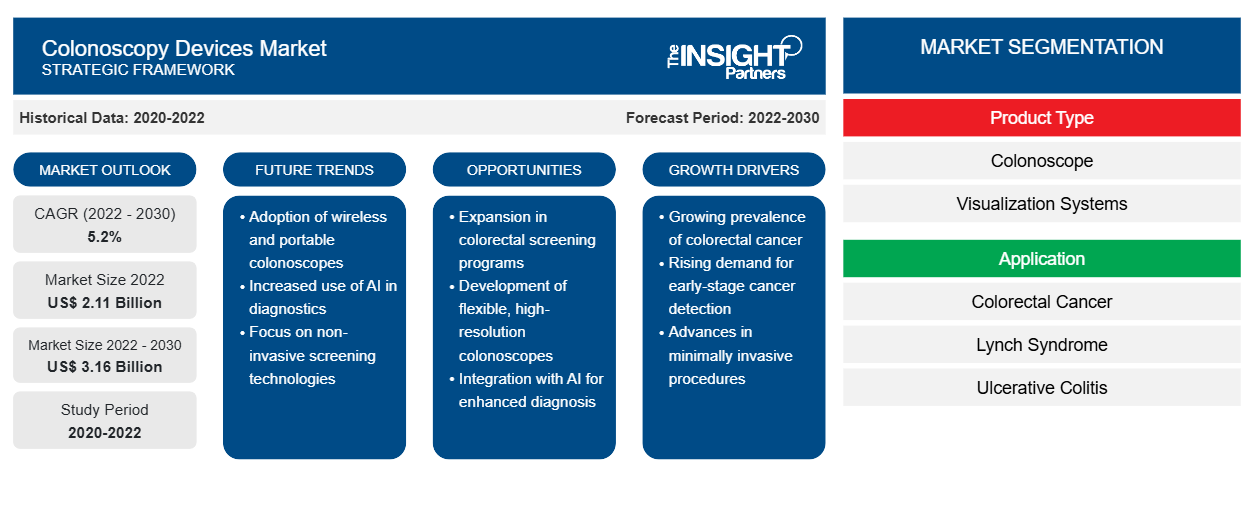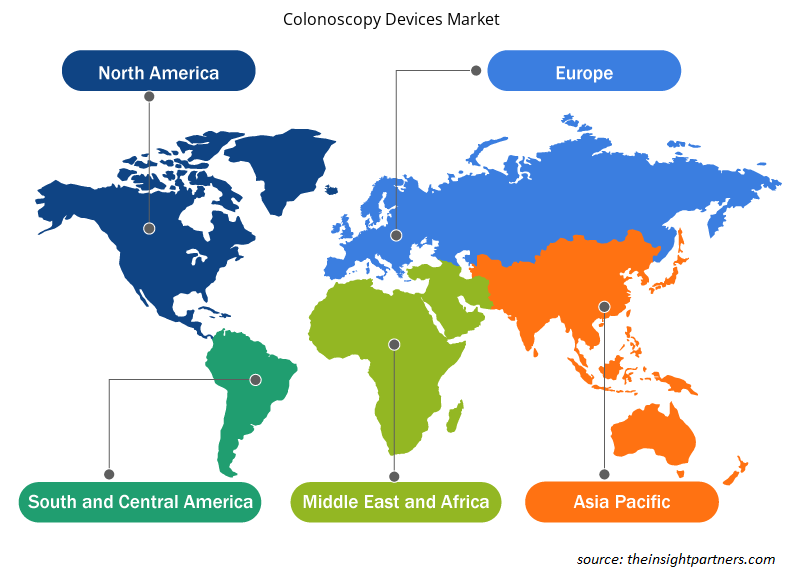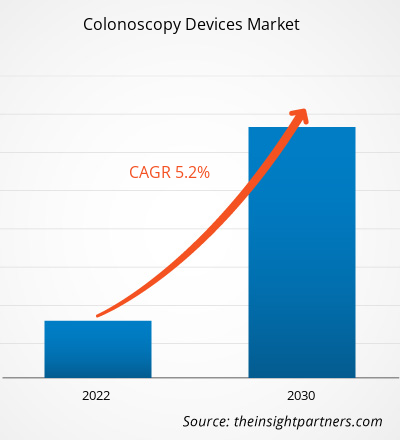[Forschungsbericht] Der Markt für Koloskopiegeräte soll von 2,30 Milliarden US-Dollar im Jahr 2024 auf 3,36 Milliarden US-Dollar im Jahr 2031 wachsen und im Zeitraum 2025–2031 eine durchschnittliche jährliche Wachstumsrate (CAGR) von 5,7 % verzeichnen.
Markteinblicke und Analystenansicht:
Die Marktprognose für Koloskopiegeräte unterstützt Marktteilnehmer bei der Planung ihrer Wachstumsstrategien. Der Bericht enthält Wachstumsaussichten sowie Markttrends für Koloskopiegeräte und deren voraussichtliche Auswirkungen im Prognosezeitraum.
Koloskopien werden mit wiederverwendbaren Endoskopen durchgeführt. Dabei handelt es sich um flexible, faseroptische Instrumente, die in den Anus eingeführt und durch den Dickdarm geführt werden. Die Koloskope helfen Endoskopikern, chronische Erkrankungen zu erkennen und Patienten auf bösartige oder präkanzeröse Erkrankungen zu untersuchen. Personen ab 50 Jahren sollten sich im Rahmen einer regelmäßigen Krebsvorsorge einer Koloskopie unterziehen. In Krankenhäusern oder ambulanten Operationszentren (ASCs) werden die Eingriffe unter leichter Sedierung durchgeführt. Die steigende Prävalenz von Darmkrebs und die zunehmende technologische Weiterentwicklung von Koloskopiegeräten durch die Hersteller tragen zum wachsenden Markt für Koloskopiegeräte bei. Die Verfügbarkeit alternativer Diagnosetests für Rektumerkrankungen hemmt jedoch das Marktwachstum.
Wachstumstreiber:
Steigende Prävalenz von Darmkrebs treibt das Marktwachstum für Koloskopiegeräte voran
Kolorektaler Krebs ist ein bösartiger Tumor, der sich im Gewebe des Rektums oder Dickdarms bildet. Rektum- und Dickdarmkrebs werden aufgrund gemeinsamer Merkmale beider Erkrankungen häufig zusammengefasst. Laut der Weltgesundheitsorganisation (WHO) ist Dickdarmkrebs die zweithäufigste krebsbedingte Todesursache weltweit. Weltweit gab es im Jahr 2020 über 1,9 Millionen Neuerkrankungen an kolorektalem Krebs und über 930.000 Todesfälle aufgrund der Krankheit. Es gab erhebliche regionale Unterschiede bei den Inzidenz- und Sterberaten. Europa, Australien und Neuseeland meldeten die höchsten Inzidenzraten, während Osteuropa die höchsten Sterberaten hatte. Laut den Daten des Europäischen Krebsinformationssystems machte Kolorektalkrebs in den 27 EU-Ländern im Jahr 2020 12,7 % aller neuen Krebsdiagnosen und 12,4 % aller durch diese Krankheit verursachten Todesfälle aus. Aufgrund der hohen Prävalenz ist er nach Brustkrebs die zweithäufigste Krebsart und nach Lungenkrebs die zweithäufigste Todesursache in Europa. Laut WHO gab es im Jahr 2020 mehr als 1,9 Millionen Neuerkrankungen an Dickdarmkrebs. Bis 2040 dürfte die jährliche Belastung durch Dickdarmkrebs auf 3,2 Millionen Neuerkrankungen (ein Anstieg um 63 %) und 1,6 Millionen Todesfälle (ein Anstieg um 73 %) ansteigen.
In den USA ist Darmkrebs die dritthäufigste Krebsart ( Hautkrebs ausgenommen ), die jährlich diagnostiziert wird. Laut der American Cancer Society wurden im Jahr 2023 in den USA rund 153.000 Menschen mit Darmkrebs diagnostiziert. Diese Zahlen umfassen 106.950 neue Fälle von Dickdarmkrebs (54.420 Männer und 52.550 Frauen) und 46.050 neue Fälle von Rektumkrebs (27.440 Männer und 18.610 Frauen). Die Koloskopie ist eine wichtige Vorsorgeuntersuchung bei Darmkrebs und gehört mittlerweile zur routinemäßigen Krebsvorsorge. Die zunehmende Prävalenz von Darmkrebs treibt somit das Marktwachstum für Koloskopiegeräte voran.
Alternativen zur Koloskopie sind die Sigmoidoskopie, eine weniger invasive Form der Koloskopie, und die Stuhlprobenuntersuchung, eine der nichtinvasiven Methoden. Seit Beginn des 21. Jahrhunderts empfehlen Ärzte die Koloskopie häufig zur Darmkrebsvorsorge bei Patienten ab 50 Jahren. In den letzten Jahren haben sie jedoch die Notwendigkeit einer Änderung ihrer Vorgehensweise erkannt. Sie befürchten die Kosten und den Aufwand einer Koloskopie, was viele Menschen von diesen Vorsorgeuntersuchungen abhält. Darüber hinaus gibt es ebenso wirksame Tests, die weniger invasiv und weniger belastend als eine Koloskopie sind. Daher behindert die Verfügbarkeit alternativer Diagnosetests das Marktwachstum für Koloskopiegeräte.
Sie erhalten kostenlos Anpassungen an jedem Bericht, einschließlich Teilen dieses Berichts oder einer Analyse auf Länderebene, eines Excel-Datenpakets sowie tolle Angebote und Rabatte für Start-ups und Universitäten
Markt für Koloskopiegeräte: Strategische Einblicke

-
Informieren Sie sich über die wichtigsten Markttrends in diesem Bericht.Dieses KOSTENLOSE Beispiel umfasst Datenanalysen, von Markttrends bis hin zu Schätzungen und Prognosen.
Berichtssegmentierung und Umfang:
Die Marktanalyse für Koloskopiegeräte wurde unter Berücksichtigung der folgenden Segmente durchgeführt: Produkttyp, Anwendung und Endbenutzer.
Segmentanalyse:
Der Markt für Koloskopiegeräte ist nach Produkttyp in Koloskope, Visualisierungssysteme und andere Produkte unterteilt. Das Koloskop-Segment hatte 2022 den größten Marktanteil. Es wird jedoch erwartet, dass das Segment Visualisierungssysteme zwischen 2022 und 2030 die höchste durchschnittliche jährliche Wachstumsrate (CAGR) verzeichnet.
Der Markt für Koloskopiegeräte ist nach Anwendung in die Bereiche Darmkrebs, Lynch-Syndrom, Colitis ulcerosa, Morbus Crohn und weitere unterteilt. Das Segment Darmkrebs hatte 2022 den größten Marktanteil und wird voraussichtlich zwischen 2022 und 2030 die höchste durchschnittliche jährliche Wachstumsrate (CAGR) verzeichnen. Die Koloskopie kann bösartige und pro-maligne Läsionen mit hoher Genauigkeit erkennen und entfernen. Sie ist ein wertvolles diagnostisches Instrument für die Darmkrebsvorsorge. Fast alle nationalen und internationalen Magen-Darm- und Krebsgesellschaften empfehlen sie als erste Screening-Methode.
Der Markt für Koloskopiegeräte ist nach Endverbraucher in Krankenhäuser, ambulante Operationszentren und andere Bereiche unterteilt. Das Krankenhaussegment hatte 2022 den größten Marktanteil bei Koloskopiegeräten und wird voraussichtlich zwischen 2022 und 2030 die höchste durchschnittliche jährliche Wachstumsrate (CAGR) verzeichnen. Dies ist auf die Einführung technologischer Fortschritte in Krankenhäusern und die zunehmende Anzahl von Screenings in Krankenhäusern zurückzuführen.
Regionale Analyse:
Der geografische Umfang des Marktberichts für Koloskopiegeräte umfasst Nordamerika, Europa, den asiatisch-pazifischen Raum, den Nahen Osten und Afrika sowie Süd- und Mittelamerika. Nordamerika hatte 2022 den größten Marktanteil. Das Marktwachstum in Nordamerika wird durch die zunehmende Belastung durch die alternde Bevölkerung, die steigende Anzahl von Produkteinführungen und F&E-Aktivitäten zur Entwicklung fortschrittlicher Koloskopiegeräte vorangetrieben.
Regionale Einblicke in den Markt für Koloskopiegeräte
Die Analysten von Insight Partners haben die regionalen Trends und Faktoren, die den Markt für Koloskopiegeräte im Prognosezeitraum beeinflussen, ausführlich erläutert. Dieser Abschnitt behandelt auch die Marktsegmente und die geografische Lage für Koloskopiegeräte in Nordamerika, Europa, Asien-Pazifik, dem Nahen Osten und Afrika sowie Süd- und Mittelamerika.

- Erhalten Sie regionale Daten zum Markt für Koloskopiegeräte
Umfang des Marktberichts über Koloskopiegeräte
| Berichtsattribut | Details |
|---|---|
| Marktgröße im Jahr 2024 | 2,30 Milliarden US-Dollar |
| Marktgröße bis 2031 | 3,36 Milliarden US-Dollar |
| Globale CAGR (2025 – 2031) | 5,7 % |
| Historische Daten | 2021-2023 |
| Prognosezeitraum | 2025–2031 |
| Abgedeckte Segmente |
Nach Produkttyp
|
| Abgedeckte Regionen und Länder |
Nordamerika
|
| Marktführer und wichtige Unternehmensprofile |
|
Marktteilnehmerdichte für Koloskopiegeräte: Auswirkungen auf die Geschäftsdynamik
Der Markt für Koloskopiegeräte wächst rasant. Die steigende Nachfrage der Endverbraucher ist auf Faktoren wie veränderte Verbraucherpräferenzen, technologische Fortschritte und ein stärkeres Bewusstsein für die Produktvorteile zurückzuführen. Mit der steigenden Nachfrage erweitern Unternehmen ihr Angebot, entwickeln Innovationen, um den Bedürfnissen der Verbraucher gerecht zu werden, und nutzen neue Trends, was das Marktwachstum weiter ankurbelt.
Die Marktteilnehmerdichte beschreibt die Verteilung der in einem bestimmten Markt oder einer bestimmten Branche tätigen Unternehmen. Sie gibt an, wie viele Wettbewerber (Marktteilnehmer) in einem bestimmten Marktraum im Verhältnis zu dessen Größe oder Gesamtmarktwert präsent sind.
Die wichtigsten Unternehmen auf dem Markt für Koloskopiegeräte sind:
- AMBU AS
- Fujifilm
- Endomed systems gmbh
- Olymp
- Pentax
- GI-Ansicht
Haftungsausschluss : Die oben aufgeführten Unternehmen sind nicht in einer bestimmten Reihenfolge aufgeführt.

- Überblick über die wichtigsten Akteure auf dem Markt für Koloskopiegeräte
Wettbewerbslandschaft und Schlüsselunternehmen:
AMBU AS, Fujifilm, Endomed Systems GmbH, Olympus, Steris PLC, GI View, Boston Scientific Corporation, PENTAX Medical, Avantis Medical Systems und SonoScape Medical Corp gehören zu den führenden Unternehmen, die im Marktbericht für Koloskopiegeräte vorgestellt werden. Diese Unternehmen konzentrieren sich auf die Entwicklung neuer Technologien, die Weiterentwicklung bestehender Produkte und den Ausbau ihrer geografischen Präsenz, um der weltweit wachsenden Nachfrage gerecht zu werden. Laut Pressemitteilungen der Unternehmen sind im Folgenden einige wichtige Entwicklungen aufgeführt:
- Im April 2021 brachte FUJIFILM Medical Systems das Koloskop der G-EYE 700-Serie auf den Markt. G-EYE, eine von Smart Medical entwickelte Technologie, unterstützt Routineuntersuchungen. Die Koloskope der G-EYE 700-Serie erweitern das innovative Koloskop-Portfolio von Fujifilm. G-EYE wird als Erweiterung der Koloskop-Familie der 700er-Serie angeboten und ist mit dem endoskopischen Videobildgebungssystem ELUXEO von Fujifilm kompatibel.
- Im Oktober 2020 erhielt Olympus die 510(k)-Zulassung und die Marktverfügbarkeit seiner beiden Koloskope PCF-H190T und PCF-HQ190. Die Produkte erweiterten die bestehenden Möglichkeiten der Ärzte zur Diagnose und Behandlung von Magen-Darm-Erkrankungen.
- Historische Analyse (2 Jahre), Basisjahr, Prognose (7 Jahre) mit CAGR
- PEST- und SWOT-Analyse
- Marktgröße Wert/Volumen – Global, Regional, Land
- Branchen- und Wettbewerbslandschaft
- Excel-Datensatz
Aktuelle Berichte
Erfahrungsberichte
Grund zum Kauf
- Fundierte Entscheidungsfindung
- Marktdynamik verstehen
- Wettbewerbsanalyse
- Kundeneinblicke
- Marktprognosen
- Risikominimierung
- Strategische Planung
- Investitionsbegründung
- Identifizierung neuer Märkte
- Verbesserung von Marketingstrategien
- Steigerung der Betriebseffizienz
- Anpassung an regulatorische Trends






















 Kostenlose Probe anfordern für - Markt für Koloskopiegeräte
Kostenlose Probe anfordern für - Markt für Koloskopiegeräte